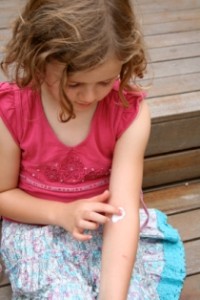Putting the Hex on Eczema
Study: Certain Vitamins, Minerals Associated with Decreased Risk for Eczema
According to the National Institute of Arthritis and Musculoskeletal and Skin Diseases, 15 million people have eczema. As surprising as this is, perhaps more surprising is the fact that 20 percent of eczema sufferers—1 in 5—are children.
But parents can reduce this common condition in childhood by seeing to it that their kids get a hefty dose of vitamins and minerals every day.
Researchers from Seoul, South Korea enlisted 180 five-year-olds, all of them having the most common form of eczema (i.e. atopic dermatitis). About 250 other five-year-olds also took part in the study, only they did not have atopic dermatitis.
But what these kids did have was a healthy dose of vitamins and minerals coursing through their blood, and researchers believe this fact was associated with their not having eczema.
After evaluating food frequency questionnaires and blood work samples, they found that the kids without eczema had high levels of beta-carotene in their blood. This was associated with a 56 percent reduced risk of atopic dermatitis.
Three other vitamins and minerals associated with reduced risk for eczema were vitamin E, folic acid and iron. Kids high in these nutrients were 67 percent, (vitamin E) 63 percent (folic acid), and 61 percent (iron) less likely to have eczema.
The study was published ahead of print in the online edition of the European Journal of Clinical Nutrition.
This study piggybacks on a study I reported about earlier this year regarding eczema prevention through the fatty acids found in fish. That study found that kids whose diets were replete in omega-3 fatty acids were 25 percent less likely to develop eczema.
About half of all kids with eczema—a skin condition that causes severe itchiness and redness—grow out of it by the age of 15, but that leaves 50 percent who are afflicted with it all their lives. And while eczema is neither deadly nor contagious, it’s a constant irritant that causes the skin to thicken and turn leathery—a source of frustration and embarrassment for sure.
Eczema can occur anywhere on the body, but it most frequently rears its ugly head on the face, arms and legs. A good friend of mine had eczema in the upper corner of his forearm and on his head. Fortunately, though, he was one of the 50 percent of kids that grew out of it.
The point of all this is to make sure your kids are getting their vitamins and minerals. Few kids get their vitamins and minerals from fresh fruits and vegetables, so a great alternative option is through multivitamin supplementation.
I recommend Ola Loa.  It’s a fun way to make sure they’re loaded with the vitamins and minerals they need, in a delicious cranberry-raspberry flavor (my personal favorite is Mango Tangerine, but the Cran Raspberry is good as well).
Sources:
yourtotalhealth.ivillage.com
nutraingredients.com
Related Posts
 
|
Enjoy this article? We guarantee your privacy. Your email address will NEVER be rented, traded or sold. |
Visit my new site: Self Help On The Web
 |
 |
Posted: February 1st, 2010 under Children's Health, Eczema.
Tags: atopic eczema, eczema treatment, eczema treatments, treat eczema







